
Elegant London Chop House reopens in downtown Detroit
3/11/2013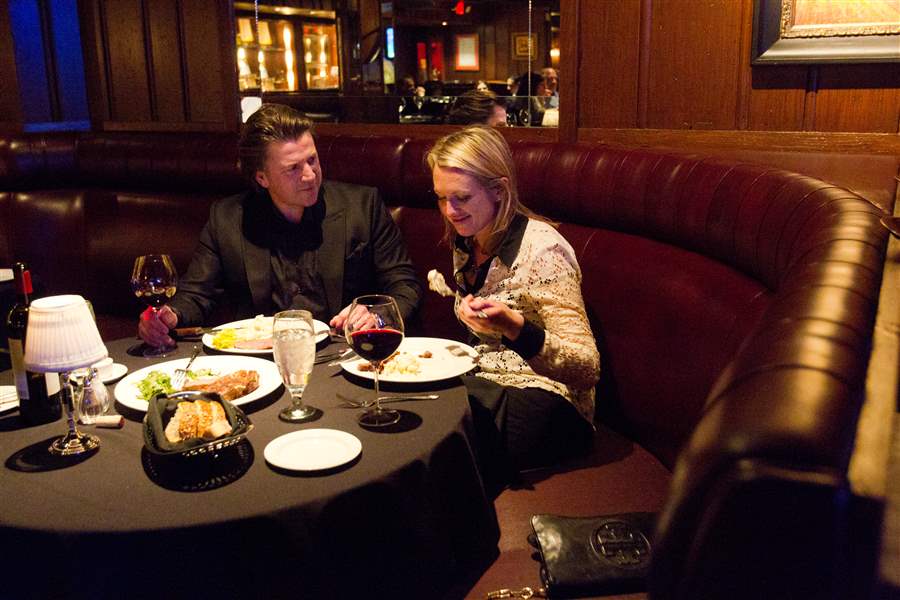
George Silva, of Toronto, left, and Maria Starrs, of Fenton, Mich., take in a meal together at the London Chop House in downtown Detroit.
THE BLADE/KATIE RAUSCH
Buy This Image
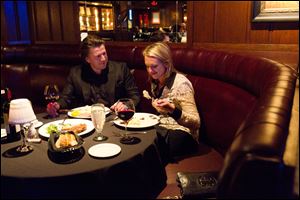
George Silva, of Toronto, left, and Maria Starrs, of Fenton, Mich., take in a meal together at the London Chop House in downtown Detroit.
DETROIT — First of all, there is the steak: a 14-ounce strip of American wagyu beef, perfectly seared, cooked, and seasoned, and as tender as a ripe pear. The garlic butter melting on top is redundant; the meat is so rich and flavorful by itself that it does not need any enhancement. On the side is a dish of roasted cauliflower in a creamy sauce of Gruyere cheese, above it is a glass of bourbon.
It is like a steak from the Golden Age of steaks and steakhouses. And so it is.
In a city noted for its Renaissance Center, one fabled restaurant is having a rebirth of its own. The London Chop House, a Detroit institution for decades that closed its doors on West Congress Street more than 20 years ago, reopened last year to considerable acclaim. The idea was to make the new restaurant a fresh take on the old classic.
“From the moment you open that door in front, you step into a different era,” said general manager Bjorn Lagerfeldt.
PHOTO GALLERY: The London Chop House
RELATED ARTICLES:
FORMER LONDON CHOP HOUSE MENUS:
The original London Chop House opened in 1938 and quickly jumped to the top of Detroit’s finest dining establishments. James Beard, the cookbook author who did as much as anyone to shape America’s culinary tastes, named it one of the 10 best restaurants in America in 1961, and Playboy magazine ranked it in the top 25 in 1980.
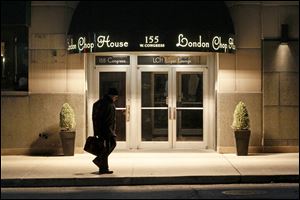
The entrance to the London Chop House in downtown Detroit features valet parking.
The restaurant thrived as Detroit did, pulsing with the electricity of success while the city’s automotive industry expanded and grew. Industry moguls dined and drank at the chop house with advertising executives, who were an equally important part of the industry. Deals were done and fortunes made over thick pieces of steak and expensive wines.
Henry Ford II was a frequent guest, as were Detroit tycoon families the Fishers and the Strohs. Bob Hope dined there, and Tallulah Bankhead and Gary Cooper. John Barrymore ate there shortly before he died and, according to a 1969 Detroit News story about the restaurant, shocked the room by drunkenly announcing exactly why he needed to go to the men’s room and what he would do once he got there. Leon Spinks autographed a menu in 1978, the year he first won and then was stripped of the world heavyweight boxing title.
Jim Hoffa, general president of the International Brotherhood of Teamsters, was a frequent guest in the 1980s.
“My law office was nearby. I would see everyone there, Lee Iacocca, Henry Ford II, a lot of famous people around Detroit were there. It was always an event to go,” he said.
“Everything was excellent. The food was perfect, the drinks were perfect. It was always a destination dinner.”
Brian McMahon, president-broker of Danberry National Ltd. in Perrysburg, visited the old restaurant fairly frequently and liked to make a night of it. He would arrive early on a Friday to ogle the occasional star or entertainer as well as all the Detroit celebrities from the worlds of business and politics.
“One of the nice things about the chop house was it was legendary. We thought going to the chop house and watching the people was almost as enjoyable as the food, and the food was outstanding,” he said.
He was particularly fond of the perch and the Doc Greene salad and for dessert would often order the gold brick sundae, with a toffee-filled hot chocolate sauce that turned hard when it touched the cold vanilla ice cream.
That menu now hangs prominently in the new restaurant, next to the bar.
Chop House Spaghetti with Oyster Sauce
12 large oysters or 24 small oysters, fresh or canned
2 tablespoons butter
4 tablespoons olive oil, divided
2 cloves garlic, finely chopped
2 tablespoons onion, chopped
Clam juice or white wine
¼ cup parsley, finely chopped
Salt and pepper, to taste
¾ pound spaghetti
1 teaspoon fresh basil, chopped, or ¼ teaspoon dried
Chop the oysters or don’t chop them, depending on your preference. James Beard prefers them chopped. Save any liquor from the oysters.
Melt butter with 2 tablespoons of the olive oil in a small skillet, add garlic and onions, and sauté until wilted and just beginning to turn golden. Add the oyster liquor plus enough clam juice or white wine to make 1 cup liquid. If you don’t have any oyster liquor, use ½ cup clam juice and ½ cup white wine. Cook this sauce down, then add ¼ cup finely chopped parsley, and salt and pepper to taste.
Meanwhile, have ready a large pan of rapidly boiling salted water to cook your pasta. Add remaining 2 tablespoons olive oil to the water to prevent the strands from sticking together, and boil the spaghetti rapidly until it reaches the stage of tenderness you like. While draining the pasta well, toss the oysters in the sauce just enough to heat them through. Add more chopped parsley and the basil. Divide the pasta among four plates, spoon the oyster sauce over it, and serve at once.
Yield: 4 servings
Source: Beard on Food: The Best Recipes and Kitchen Wisdom from the Dean of American Cooking, by James Beard
Stuffed Burger Like the Pancho Burger
1 medium onion, chopped
3 Tablespoons salad oil
2 cloves garlic, minced fine
2 pounds ground beef chuck
2 eggs
1 tablespoon chopped parsley
1 teaspoon salt
¼ teaspoon pepper
¼ cup crumbled Roquefort cheese
2 tablespoons butter, softened
2 tablespoons brandy
Sauté onion in oil until transparent. Add garlic and cook 1 minute. Drain, cool, and add to ground beef. Add eggs, parsley, salt, and pepper; mix well with hands. Form into 4-6 meatballs. Make stuffing mixture by combining Roquefort cheese, soft butter, and brandy. Form into balls. Make a deep hole in the side of each meatball and fill with this mixture. Mold meat over the opening. Brush with oil, sprinkle with salt and pepper, and broil close to heat until browned on both sides, approximately 5 minutes on each side. Serve with Pancho Sauce, below, preferably between English muffins. May also be served as hors d'oeuvres or baked as meat loaf in 350° oven about 1 hour.
Yield: 4-6 servings
Source: Bob & Rob Allison's Ask Your Neighbor
Pancho Sauce
1 cup ketchup
½ cup mayonnaise
½ cup chili sauce
1 tablespoon dry mustard
1 teaspoon prepared horseradish
½ teaspoon ground ginger
¼ teaspoon meat tenderizer, such as Accent (monosodium glutamate)
2 tablespoons pineapple juice
1 tablespoon wine vinegar
2 tablespoons Worcestershire sauce
3 drops Tabasco sauce
Combine all ingredients well. Serve warm or cold.
Yield: About 1½ cups
Source: Bob & Rob Allison’s Ask Your Neighbor
Longtime Toledo restaurateur Fifi Berry, who owned both Fifi’s and Fifi’s Reprise, said, “I was a London Chop House fan. … It was exciting; it was happy.”
“It was just the place to be on a weekend night. People were dressed fabulously,” she said.
“They had a huge menu. They had a wonderful wine list at the time, one of the best wine lists around.”
All the details were perfect, she said, from the food all the way down to the women’s restroom, which was very clean and well-appointed and staffed by an attendant.
By the time she opened her first restaurant in 1980, the chop house had changed hands and had lost some of its ambiance and style, Ms. Berry said.
“It wasn’t the same caliber of restaurant,” she said.
While every restaurant Ms. Berry visited helped to inform the way she ran her establishments, she believes the London Chop House may be particularly responsible for her offering the Tom and Jerry as a drink. Essentially an eggnog spiked with rum and served hot, the Tom and Jerry was a popular holiday treat at both the chop house and Fifi’s.
Ruthann Logsdon Zaroff, now of Belleville, Mich., was an up-and-coming singer in her 20s when she would frequent the restaurant. Part of the draw, she said, was the possibility of rubbing shoulders with someone famous, though the only star she saw there was Mike Connors of the television detective show Mannix.
“The food was really, really good and the service was always impeccable. I was young, but they treated me like an adult, so that made me feel special,” she said.
In her mind, the chop house was the epitome of fine dining. Whenever she had a boyfriend she was thinking seriously about, she would have him take her there as a kind of tryout.
“This was the benchmark for me, this was the sine qua non. To me, if a guy could take me there and behave properly, dress properly, order properly, then they passed the test.”
Reviving history
As the city of Detroit faltered and failed, so did the London Chop House. Hard times for the city brought hard times for the restaurant. It closed in 1991, its expansive space sitting empty on the lower level of the Murphy-Telegraph Building downtown ever since, with the exception of a few years when it was a club.
That is when Nico Gatzaros stepped in. Mr. Gatzaros is the son of Detroit entrepreneur Ted Gatzaros, who died earlier this year. The older Mr. Gatzaros and his former partner opened the Greektown Casino, operated several restaurants in town, and owned a number of buildings, including the Murphy-Telegraph Building. Nico Gatzaros had the idea to open a cigar bar in the space of the old London Chop House.
Word leaked out about the planned opening, but the details were muddled. The Detroit News ran a story that the family was going to reopen the iconic restaurant.
“My mom and dad got bombarded with phone calls,” Nico Gatzaros said. “My mom called me up and said, ‘You’re not lighting one cigar in there.’ ”
He shifted gears, tore the kitchen down to the studs, and determined to bring the restaurant back to its earlier glory (the wood-paneled cigar bar was opened in a different space on the first floor). The 43-year-old entrepreneur is too young to remember much about the restaurant before it closed, but he knew it had “an outrageous history” and that it had long been a draw for Detroit’s elite.
The renovation cost more than $1 million but less than $5 million — Mr. Lagerfeldt would not be more specific than that — and that price could be achieved only because, as owners of several buildings, they had access to construction crews. When previous owners had remodeled the room, they did not tear anything down, they built on top of it. As a result, the new work required removing three remodelings’ worth of decor.
Gone were the old ceiling fans that hung down to draw away the thick cigarette smoke of 1960s nightlife, gone was the dingy old carpet and the dried and cracked leather upholstery on the banquettes.
But the banquettes themselves were saved, reupholstered, and replaced exactly where they had been before. The long wooden bar with the mirror behind the bottles was polished and restocked. Even the old phone booths with the wood-and-glass doors were retained, though the working payphones inside are new.
“Everybody tells me it’s like walking backwards in time,” Mr. Gatzaros said.
Most important, Mr. Lagerfeldt said, the new owners brought back a high level of service. The restaurant has a doorman and a valet parker, live music five nights a week, and dancing as the night goes on. Members of the staff buy drinks for customers and give them a rain check to collect it.
“It doesn’t matter what you’re selling, it’s the relationship that ultimately brings people back,” Mr. Lagerfeldt said.
Classic recipes
In the old restaurant’s heyday, customers who had made reservations were greeted with a book of matches on their table with their name embossed on it (they also received a dime to repay the cost of the call to make the reservations). The manager said the restaurant would love to be able to do that again, and it even has the old machine it used to print the names on the matchbooks, but they so far have been unable to find a ribbon to fit it.
The printing machine, which is less than a foot high, is on display in a glass case, along with several examples of the matchbooks, a couple of credit cards the restaurant had formerly issued, and a number of the iconic caricatures drawn of its patrons by artist-in-residence Hy Vogel. Back in the day, it was considered a high honor to have your caricature hung on the beveled ceiling, one of the few distinguishing features of the old restaurant that is not being re-created today.
The seasonally changing menu, though, has many of the same dishes that helped make the old restaurant famous, though the prices are of course much higher. The veal cutlet Oscar, which was $11.75 in 1978, is now a veal chop Oscar for $45. The filet mignon, which was served en brochette (on skewers) in 1969 for $5.95, is now $32 for 6 ounces. Steak tartar, which was $6.95 almost 45 years ago, is now an appetizer at $16 — and is highly recommended both by Mr. Lagerfeldt and executive chef R.J. Scherer.
Just 28, Mr. Scherer is a native of the Detroit area. After graduating from the Culinary Institute of America in New York, he accepted a job at Emeril Lagasse’s New Orleans Fish House at the MGM Grand Casino in Las Vegas. He quickly worked his way up to be executive sous chef, the kitchen’s second in command.
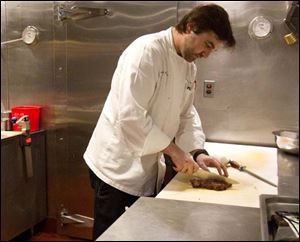
Executive chef Robert Scherer, right, slices a steak Friday at the London Chop House in downtown Detroit. "All the preparations are what I would call 'old school.'"
When he told his boss that he was offered a job opening a restaurant in Detroit, his boss scoffed, saying there no projects worth working on in Detroit. His boss gave him his blessings when he said the restaurant he was opening was the London Chop House.
“I took the menu items that they were known for back in the ’70s, ’80s, and ’90s. I wanted to make them still appeal to the modern diner,” Mr. Scherer said.
“All the preparations are what I would call ‘old school.’ Everything is from scratch. All the veal stocks, soups, and sauces are made from scratch,” he added, pointing to vats of veal stock that he would later reduce for 13 hours until they turned into demiglace. The demiglace would then be used for everything from short ribs to sauces to, incredibly, the French onion soup, where it would be mixed with veal stock to create a luxuriant broth.
The classic recipes, elegance, and charm have been bringing back older customers, including many who remember the old chop house from its glory days. But the staff knew it had to make a conscious effort to attract younger patrons, as well. And so some the old recipes have a modern twist; the steak tartar, for instance, is served with a porcini vinaigrette and a layer of frisee separating the chilled meat from a warm, soft-poached egg and a shaving of truffle.
In a very early review published just two weeks after the restaurant opened, the Detroit News’ Molly Abraham, the dean of Detroit’s restaurant critics, wrote an entirely favorable review. She praised the restaurant’s new look, acknowledging it had turned a bit tacky in its waning years, and gave high marks to all the food she tried, including marinated lamb chops, the 24-ounce, bone-in ribeye steak, and the sauteed lake perch.
“The updated version of the old watering hole is looking very promising,” she wrote.
Some things change. The dress code has been relaxed, if reluctantly. Where men formerly had to wear jackets and ties, they now are asked only to wear a shirt with a collar, no hats, and no torn jeans. Tennis shoes are discouraged, but Mr. Lagerfeldt said, “the reality is when people are going anywhere these days, blue jeans are acceptable.”
The younger crowds are coming in, as they had hoped, but Mr. Lagerfeldt has noticed they tend to arrive later in the evening.
Celebrities return
Larry Burns, vice president for external affairs at the University of Toledo, has been witness to both phases of the restaurant, its former glory and its restored sheen. A native of Detroit who occasionally accompanied his parents to the chop house when he was a child in the ’60s, he also paid visits to it as a young professional in the ’80s.
“That was sort of the Wall Street, Gordon Gekko era,” he said, citing the money-obsessed anti-hero of the movie. “It had that New York, 21 sort of feel.”
When the restaurant closed in 1991, he saw it as a symbol of what was happening to Detroit at the time. “It was part of Detroit’s glamorous history going away.”
“So when it was reopened in a way that very much mimics what it was, it was very uplifting. Walking in the restaurant you have a very déjà vu feeling that it is the same place. It’s not smoky, of course, but it gives you a vibe that things are happening,” he said.
Even the celebrities are back. In the ’60s, it was a favorite hangout for Frank Sinatra. The last time Mr. Burns was there, he saw Kid Rock (“He couldn’t have been nicer”). The time before, he ran into the offensive line for the Minnesota Vikings, who were dining out before their game the next day.
When the old restaurant was at its peak, the legendary Jose Reyes held court behind the bar. The late Mr. Reyes often poured two drinks that, the story goes, may have been invented there: the Hummer, which is a mixture of ice cream, Kahlua, and rum, and the Bull Shot, which mixes vodka with beef bouillon.
The new bar manager, Victor Hurd, said the Bull Shot may have been invented across the street at the Caucus Club nightclub, which was opened by the same owners and shared a kitchen, which was connected by a tunnel under Congress Street. The Caucus Club, which closed last year after 60 years of business, was widely recognized as the place where Barbra Streisand first began her career when she was just 18.
Mr. Hurd made a lot of Hummers when the London Chop House first reopened and still sells a fair number of them today, a year later. But he generally tries to discourage people from drinking Bull Shots, which he regards as “more of a novelty than anything else.”
Variety of wine
He is prouder of the cellar of wines he put together for the restaurant, which can run as high on the specialty wine list as $2,800 for a bottle of 1988 Chateau Le Pin or a 1967 Chateau Latour for $900. The basic wine list reaches as high as $325 but is weighted more toward “wines that overdeliver at $40,” he said.
“You’d say, ‘Wow, I would have paid more for that and been happy,’” he said.
The restaurant currently offers more than 180 wines by the bottle and pours 24 wines by the glass, and Mr. Hurd said he is always looking to expand and improve the list. “It’s like any business: If you get comfortable, you will fail,” he said.
However, the wines are not as numerous as those offered at, say, New York’s famed 21 restaurant, which just received the highest-rated Grand Award from Wine Spectator magazine for the 10th straight year.
“Where we are right now, we have a little room for expansion, for sure. We are not looking to be a 3,000-bottle list. I don’t think that would be a wise idea for us,” Mr. Hurd said.
“We’re not New York. We’re not going to get so many people coming in here from so many different locations that I need to have 90 different Spanish reds. On the other hand, I don’t want someone to come in and not find something not on the beaten path.”
So he chooses a combination of better-known wines and varieties that are less popular. He may choose only one or two labels of the less-known varieties, but he looks for a representative sample that is particularly good for its price point, he said.
“Even something as simple as a Grüner Veltliner, we only have one but I tasted nine different ones before I picked the one I decided on,” he said. “We’re not New York where I have a $300,000 wine budget and can have a whole category of those.”
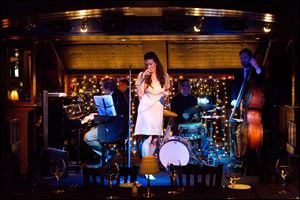
Nicole New, of Detroit, center, sings with the Scott Gwinell Trio on Friday evening. The restaurant features a jazz trio or a classical pianist five nights a week, and dancing as the night goes on.
Building reputation
The restaurant is still building its base and reputation. It is crowded on Saturday nights and to a degree on Fridays, but the weeknight business depends largely on whether there is an event downtown. They do very well, Mr. Lagerfeldt said, when something is going on at the nearby convention center.
Can the chop house ever reclaim its former glory? At its peak, it was more than a restaurant, it was an institution — and one with enough esteem to be mentioned in a number of books.
In Jim Harrison’s 2005 novella Republican Wives, one character wooed another by reminding her of the “wonderful lunches” they used to share there. In his 2005 memoir Apple’s America: The Discriminating Traveler’s Guide to 40 Great Cities, R.W. Apple, Jr., called it “a clubby restaurant that served better food and wine than any club I know.” In a 1974 piece reprinted in The Armchair, James Beard, the cook and author, described the “famous hamburger” which was “done with cognac and freshly ground pepper and flambéed.”
Detroit is still a troubled city struggling to survive. The race riot of 1967 took its toll, and the political atmosphere that followed combined to drive many wealthy and middle-class whites and blacks to the suburbs. In his 1993 book The Geography of Nowhere: The Rise and Decline of America’s Man-Made Landscape, James Howard Kuntsler writes, “Today, Detroit suburbanites pride themselves on never having to cross Eight Mile Road, the city’s boundary.”
But that was 20 years ago. Times and attitudes change. The question is whether they have changed enough to support a high-end, fine-dining restaurant in downtown Detroit.
The Gatzaros family is banking that they have. According to Mr. Lagerfeldt, “their passion has always been Detroit. They chose to stay in Detroit when a lot of people were leaving Detroit.”
Mr. Gatzaros believes that Detroit is coming back. “A lot of the buildings downtown are getting occupied, like they were back in the day. It’s hard to find an apartment in [downtown] Detroit these days,” he said.
The London Chop House is one more step in the city’s renaissance. It brings class to a town that is badly in need of it.
The London Chop House is at 155 W. Congress St., Detroit. Open for lunch 11 a.m.-3 p.m. Monday-Friday; open for dinner 5-10 p.m. Monday-Thursday, 5-11 p.m. Friday-Saturday. The bar is open 11 a.m.-11 p.m. Monday-Wednesday, 11 a.m.-midnight Thursday, 11 a.m.-1 a.m. Friday, and 4 p.m.-1 a.m. Saturday. 313-962-0277.
Contact Daniel Neman at: dneman@theblade.com or 419-724-6155.